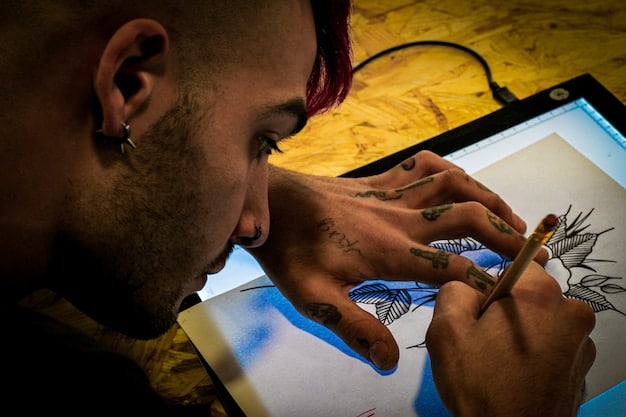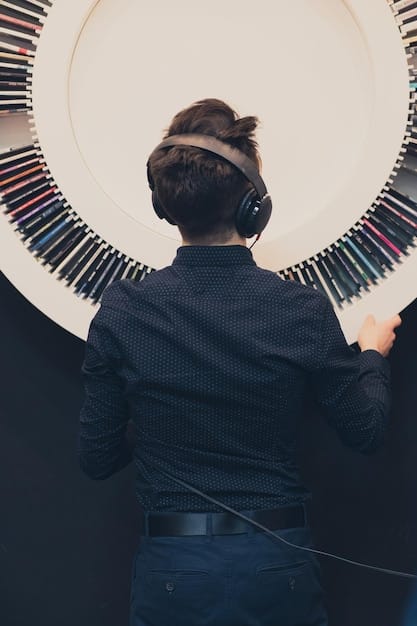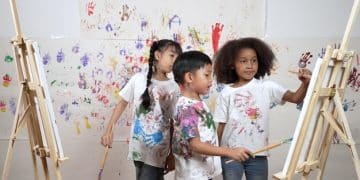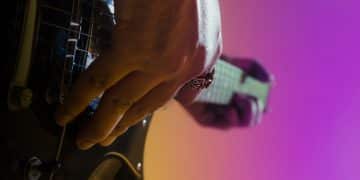Art in the Age of AI: Transforming US Creative Industries

Art in the Age of AI: How Artificial Intelligence Is Transforming US Creative Industries delves into the profound impact of AI on creative industries in the US, exploring new tools, workflows, and the evolving role of artists in an AI-driven landscape.
The rise of artificial intelligence is not confined to science and technology; it’s rapidly permeating the arts, redesigning creative industries across the US. Art in the Age of AI: How Artificial Intelligence Is Transforming US Creative Industries calls for an examination of these transformations.
The Dawn of AI-Assisted Art
Artificial intelligence is no longer a futuristic concept; it’s a present-day tool that’s reshaping how art is created, distributed, and experienced. US creative industries are at the forefront of this revolution, experimenting with AI to push artistic boundaries and explore uncharted territories.
This collaboration between humans and machines promises to unlock new creative potentials, while also raising important questions about authorship, originality, and the very definition of art.
AI as a Creative Partner
AI tools are enabling artists to accomplish tasks with speed and precision that would be nearly impossible otherwise.
- Generating variations: AI can rapidly generate numerous iterations of a design, allowing artists to swiftly explore different styles and aesthetics.
- Assisting with complex tasks: From creating intricate patterns to composing complex musical arrangements, AI can handle challenging aspects of art production.
- Personalizing experiences: AI can also tailor art experiences to individual preferences, creating personalized artworks and interactive installations.
AI provides artists with new palettes, brushes, and instruments, enhancing their creative toolbox and enabling them to explore artistic possibilities previously unimagined.

The integration of AI in art also raises philosophical questions about the role of the artist. Is the AI a tool, a collaborator, or something else entirely?
AI in Visual Arts: A New Canvas
In the visual arts, AI algorithms are being employed to generate stunning imagery, manipulate photos and videos, and even create entirely new forms of digital art. These advancements have opened up new avenues for artists to explore their creative visions.
From painting and sculpture to photography and digital design, AI is leaving its mark on every corner of the visual arts landscape in the US.
AI-Driven Image Generation
AI art generators enable artists to create unique and captivating visuals by simply entering a text prompt.
- Text-to-Image Synthesis: Type a description, and the AI generates a corresponding image, offering artists unprecedented expressive control.
- Style Transfer: Transform your photos into the style of famous painters, or create entirely new artistic styles with AI-powered style transfer tools.
- Automated Image Enhancement: AI can automatically enhance the quality and composition of images, saving photographers time and effort.
This offers artists the ability to explore complex ideas and translate abstract concepts into visual form with remarkable speed and accuracy.
AI tools can create pieces tailored to specific tastes or requirements by analyzing user data and preferences, opening doors for personalized art experiences.
The Impact on Music Composition
The music industry is also experiencing a paradigm shift. AI is assisting composers with generating melodies, harmonies, and rhythms, leading to fresh sounds and new approaches to music creation. AI’s capacity for pattern recognition and processing large datasets makes it a powerful tool for musicians.
AI is reshaping how music is composed, performed, and experienced, across genres and styles.
AI as a Musical Muse
AI systems contribute to music creation by analyzing vast libraries of music, identifying patterns, and generating novel compositions.
- Automated Composition: AI algorithms can generate original melodies, harmonies, and rhythms based on user-defined parameters.
- Sound Design: AI tools enable musicians to create unique sounds and manipulate existing ones, opening up opportunities for experimental soundscapes.
- Personalized Music Experiences: AI algorithms can tailor music playlists and compositions to individual listener preferences.
By suggesting complementary chord progressions or identifying harmonious instrumental combinations, AI enhances productivity and experimentation.

AI can also analyze listener data to identify patterns and generate personalized music recommendations, optimizing the listening experience.
AI and the Performing Arts
The performing arts are taking note of AI’s growing influence, exploring how technology can augment performances and revolutionize audience engagement. AI’s role includes creating interactive experiences and enabling artists to push the envelope in performance.
Dance, theater, and live music are all harnessing the power of AI to deliver unique and immersive experiences.
AI-Enhanced Performances
From interactive stage designs to AI-driven choreography, AI offers unique opportunities to create engaging spectacles.
- Interactive Installations: Stage designs that transform, adapt, and respond to the actions of performers and audience members create unforgettable experiences.
- AI-Driven Choreography: AI enables dancers to explore new forms of movement and expression, pushing the boundaries of physical performance.
- Personalized Theater Experiences: AI can adjust the narrative and atmosphere of a play in real time, creating a unique experience for each audience member.
AI systems are being used to analyze audience reactions and adjust the performance accordingly, ensuring optimal engagement and enjoyment, resulting in dynamic and memorable performances.
AI opens doors for creating more immersive and interactive performance experiences.
The Ethical Considerations
The integration of AI into US creative industries introduces ethical considerations. Addressing concerns about data privacy, algorithmic bias, and equitable access remains critical as AI becomes more pervasive.
Striking a balance between innovation and responsibility is essential to ensuring that AI benefits all members of the creative community.
Navigating the Ethical Landscape
As AI-generated art becomes more prevalent, it is essential to consider the ethical implications.
With proper safeguards, AI can revolutionize creative industries while upholding values of fairness, inclusivity, and respect. The ongoing discussion about the ethical dimensions of AI in art is imperative.
These discussions encompass the protection of intellectual property, the prevention of misuse, and the encouragement of transparency in AI systems.
The Future of Creativity
As AI continues to evolve, its role in US creative industries will inevitably deepen. The future holds exciting possibilities for synergistic collaborations between humans and machines.
The convergence of art and technology promises to unlock new creative frontiers and redefine the boundaries of human expression.
Embracing the Unknown
The transformative impact of AI on creative industries is still in its early stages.
This requires flexible adaptation, continuous education, and a willingness to embrace the unique opportunities that AI presents. The future invites collaboration between humans and AI to spark new horizons in artistic expression.
The possibilities are boundless, and the journey is just beginning. As AI technologies develop, they will likely shape how art is conceived, created, and appreciated in ways we can scarcely imagine today.
| Key Point | Brief Description |
|---|---|
| 🎨 AI-Assisted Art | AI tools are enhancing creative workflows and opening new artistic potentials. |
| 🖼️ AI in Visual Arts | AI algorithms are generating stunning imagery and new forms of visual art. |
| 🎵 Impact on Music | AI is assisting composers and generating fresh approaches to music creation. |
| 🎭 Performing Arts | AI augments performances and revolutionizes audience engagement. |
Frequently Asked Questions
▼
AI is enabling artists to generate images from text, manipulate photos, and create new digital art forms, offering unprecedented expressive control through tools like text-to-image synthesis and style transfer.
▼
Ethical considerations include data privacy, algorithmic bias, intellectual property rights, and equitable access to AI tools. These challenges require careful management to ensure fairness and integrity.
▼
AI systems analyze vast music libraries, identify patterns, and generate original melodies, harmonies, and rhythms. They also enhance sound design and personalize listener experiences effectively.
▼
AI enhances performances through interactive stage designs, AI-driven choreography, and personalized theater experiences by adjusting narrative and atmosphere in real time, creating highly engaging spectacles.
▼
The future involves deeper synergy between humans and machines, unlocking new creative frontiers and pushing the boundaries of human expression. Embrace continuous education and adaptation.
Conclusion
In conclusion, the integration of AI is transforming US creative industries, offering new tools, workflows, and opportunities while also presenting ethical challenges. Navigating these dynamic changes with creativity, responsibility, and vision will shape the future of art and human expression.





